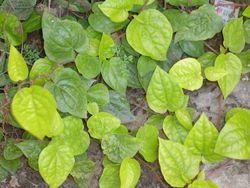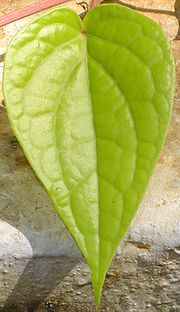Contents:
Common Names | Parts Usually Used | Plant(s) & Culture | Where Found | Medicinal Properties | Biochemical Information
Legends, Myths and Stories | Uses | Warning | Resource Links
Scientific Names

- Piperales
- Piperaceae family
- Piper betle
Common Names
- Betel
- Paan (Urdu language)
- Taambuul (Sanskrit name)
- Nagavalli (Sanskrit name)
- Vetrilai (Tamil language)
- Tamalapaku (Telugu language)
- Vidyache pan (Marathi language)
- Vilya (Kannada language)
- Veeleya (Kannada language)
- Vettila (Malayalam language)
- Plu (Mon language)
- Malus (Tetum language)
- Maluu (Khmer language)
- Plue (Thai language)
- Bulath (Sinhalese language)
- Malu (Tokodede language)
- Bileiy (Divehi language)
- Bulung samat (Kapampangan language)
- Daun sirih (Malay language)
- Papulu (Chamorro language)
- Tråu (Vietnamese language)
Parts Usually Used
 Leaf
Leaf
Back to Top
Description of Plant(s) and
Culture
The betel plant is an evergreen and perennial creeper, with glossy heart-shaped leaves and white catkin. The Betel plant originated from South and South East Asia (India and Srilanka).
Back to Top
Where Found
The betel leaf is cultivated in most of South and Southeast Asia. Since it is a creeper, it needs a compatible tree or a long pole to prop the vine against it.
Paan cultivation is a special type of agriculture. High land and special fertile soil are best for betel. Waterlogged, saline and alkali soils are unsuitable for its cultivation. Farmers who are called barui prepare garden for this. Paan garden is called barouj. Barouj is fenced with bamboo sticks and coconut leaves and on top it is also covered by paddy leaves. The land is dug well and laid out into furrows of 10-15 m length, 75 cm width and 75 cm depth. Oil cakes, cow dung, rotten farmyard manure and leaves are thoroughly incorporated with the topsoil of the furrows and wood ash. The creeper cuttings are planted after proper dressing in the months of May and June, at the beginning of the monsoon season. The plants are neatly arranged in parallel rows about two feet apart, and the saplings are twined around upright sticks of split bamboo and reeds.
Proper shade and irrigation are essential for the successful cultivation of this crop. The plants are regularly watered in the hot months. The leaves of the plant become ready for plucking after one year of planting and the production of the barouj lasts for several years from the date of planting. Betel needs constantly moist soil, but there should not be excessive moisture. Hence, frequent light irrigations are given. The quantity of irrigation water should be such that the standing water should not remain for more than half an hour in the bed. If water logging by heavy rains or excess irrigation occurs, drainage should be arranged immediately. The best time for irrigation is morning or evening.
Dried leaves and wood ash are applied to the furrows at fortnightly intervals and cow dung slurry is sprinkled. Application of different kinds of leaves at monthly intervals is found advantageous for the growth of the betel.
Betel leaf and Areca nut consumption in the world.
In about 3-6 months time, vines grow to a height 150-180 cm. At this stage branching is noticed in the vines. Leaves are removed along with the petiole with the right thumb. Once harvesting is commenced, it is continued almost every day or week. The interval of harvesting varies from 15 days to about a month till the next lowering of vines. After each harvest, manuring has to be done.
There are various types of leaves, the most popular being : Calcutta, Banarasi, Maghai, etc. In South Asia Dinajpur, Rangpur, Chittagong, Faridpur, Jessore, Narayanganj, Barisal and Sylhet are the areas producing most betel. The harvested leaves are used both for domestic consumption and for export to Middle East, to European countries, USA, UK, Pakistan, and Myanmar. Paan is one of the major economic sources of rural Bangladesh. The best Betel leaf is the “Magadhi” variety (literally from the Magadha region) grown near Patna in Bihar, India. In Kerala, the famous variety of betel leaf is from Venmony near Chengannur and it is called “Venmony Vettila”. Betel leaf cultivated in Tirur, Kerala is also of fine quality. Betel leaves exported from Tirur are famous in Pakistan as “Tirur Pan”.
Back to Top
Medicinal Properties
It is valued as a mild stimulant.
Back to Top
Biochemical Information
The active ingredients of betel oil, which is obtained from the leaves, are primarily a class of allylbenzene compounds. Though particular emphasis has been placed on chavibetol (betel-phenol; 3-hydroxy-4-methoxyallylbenzene), it also contains chavicol (p-allyl-phenol; 4-allyl-phenol), estragole (p-allyl-anisole; 4-methoxy-allylbenzene), eugenol (allylguaiacol; 4-hydroxy-3-methoxy-allylbenzene; 2-methoxy-4-allyl-phenol), methyl eugenol (eugenol methyl ether; 3,4-dimethoxy-allylbenzene), and hydroxycatechol (2,4-dihydroxy-allylbenzene).
Several terpenes and terpenoids are present in the betel oil as well. There are two monoterpenes, p-cymene and terpinene, and two monoterpenoids, eucalyptol and carvacrol. Additionally, there are two sesquiterpenes, cadinene and caryophyllene.
Legends, Myths and Stories
There is archaeological evidence that the betel leaves are chewed along with the areca nut since very ancient times. It is not known, however, when these two different stimulants substances were put together for the first time. In most countries the mixture of both has a ceremonial and highly symbolical value.
In India, Burma, Nepal, Sri Lanka and other parts of South Asia, as well as Southeast Asia, the leaves are chewed together in a wrapped package along with the areca nut (which, by association, is often inaccurately called the “betel nut”) and mineral slaked lime (calcium hydroxide). Catechu, called “Kattha” in Hindi, and ther lavoring substances and spices might be added. The lime acts to keep the active ingredient in its freebase or alkaline form, thus enabling it to enter the bloodstream via sublingual absorption. The areca nut contains the alkaloid arecoline, which promotes salivation (the saliva is stained red), and is itself a stimulant. This combination, known as a “betel quid”, has been used for several thousand years. Tobacco is sometimes added.
The betel and areca also play an important role in Vietnamese culture. In Vietnamese there is a saying that “the betel begins the conversation”, referring to the practice of people chewing betel in formal occasions or “to break the ice” in awkward situational conversations. The betel leaves and areca nuts are used ceremonially in traditional Vietnamese weddings. Based on a folk tale about the origins of these plants, the groom traditionally offer the bride’s parents betel leaves and areca nuts (among other things) in exchange for the bride. The betel and areca nut are praised as an ideal combination to the point that have become important symbols of the ideal married couple bound together in love. Therefore in Vietnamese the phrase “matters of betel and areca” (chuyện trầu cau) is synonymous with marriage.
The addition of tobacco leaf (the most harmful and addictive component) to the chewing mixture is a relatively recent one, introduced during colonial times a mere few centuries ago.
The muddling between the betel leaf and the areca nut, by calling the nut “betel nut”, is restricted to the colonial languages, like English, French, Dutch and German. This lack of accuracy is likely a legacy of the colonial era in which chewing the mixture was restricted to “the natives”. In the languages of the places where the Areca nut is traditionally chewed there is a clear and separate term for the areca nut and another for the betel leaf. This clear distinction is important in societies where both the areca nut and the betel leaf have a ceremonial and even sacred value. Furthermore, there is commonly a specific verb for the activity of chewing both of them together.
There was a certain amount of prejudice among the European colonial powers against the tradition of chewing of Areca nut and betel. Unlike the quick adoption of tobacco by Europeans in the American colonies, chewing areca nut and betel was an addictive habit not adopted by the colonizers of South and Southeast Asia. Officers freshly posted in the East India or Indochina colonies, whether British, French or Dutch, regarded the red-stained mouths of pan-chewers with dread, as something too foreign for them. This abhorrence is not only evident in the writings of authors of the Victorian era, but also in the works of more recent writers like George Orwell, Somerset Maugham and V.S. Naipaul. Often this spirit expresses itself in mockery and ridicule, like in the Broadway musical South Pacific tune “There Is Nothing Like a Dame,” with the line “Bloody Mary’s chewing betel nuts… and she don’t use Pepsodent.”
Uses
Betel leaves are used as a stimulant, an antiseptic and a breath-freshener Paan. In India, the betel and areca play an important role in Indian culture, especially among Hindus. Many traditional ceremonies governing the lives of Hindus use betel and areca. For example to pay money to the priest, they keep money in the betel leaves and place it beside the priest.
In India, betel is used to cast out (cure) worms. And according to traditional Ayurvedic medicine, chewing areca nut and betel leaf is a good remedy against bad breath (halitosis). They are also said to have aphrodisiac properties.
In Malaysia they are used to treat headaches, arthritis and joint pain. In the Philippines, Thailand, Indonesia and China they are used to relieve toothache. In the Philippines, they are used specifically as a stimulant. In Indonesia they are drunk as an infusion and used as an antibiotic. They are also used in an infusion to cure indigestion, as a topical cure for constipation, as a decongestant and as an aid to lactation.
A related plant P. sarmentosum, which is used in cooking, is sometimes called “wild betel leaf”.
Back to Top
Warning
The high rate of oral cancer in India is thought to be due to the chewing of betel preparations, though it is unclear whether this can be attributed to the betel leaf, the areca nut, or to the tobacco which is added to some betel preparations. There is an association between the chewing of betel preparations and oral and esophageal squamous cell carcinoma. It is also unclear whether similar health risks exist with traditional recipes as those that are associated with modern betel mixtures.
Back to Top
